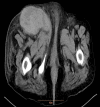Post-procedural necrotizing fasciitis following femoral coronary angiography in patient with chronic endocarditis: A case report
- PMID: 39717167
- PMCID: PMC11663443
- DOI: 10.48305/arya.2024.42517.2944
Post-procedural necrotizing fasciitis following femoral coronary angiography in patient with chronic endocarditis: A case report
Abstract
Background: Necrotizing fasciitis is a life-threatening soft tissue infection characterized by rapid tissue necrosis, often leading to sepsis and multisystem organ failure. Necrotizing fasciitis can rarely occur as a post-procedural complication, particularly following cardiac catheterization or angiography. This case report presents the clinical presentation and management of a 64-year-old female with a history of chronic endocarditis and valvular involvement who developed necrotizing fasciitis after femoral coronary angiography.
Case presentation: A 64-year-old female with a history of chronic endocarditis and valvular involvement underwent femoral coronary angiography as part of her cardiac evaluation. On the first postoperative day, the patient developed worsening pain, swelling, and redness in her right lower extremity, which worsened despite antibiotic therapy and pain management. The patient was diagnosed with necrotizing fasciitis. An emergent right lower extremity fasciotomy was performed to debride the necrotic tissue and release the tension caused by acute compartment syndrome.
Conclusion: This case underscores the importance of maintaining a high index of suspicion for NF in patients with persistent soft tissue infection symptoms post-procedure. Early recognition, prompt diagnosis, and aggressive surgical intervention are crucial for the successful management of post-procedural NF following femoral coronary angiography. This report emphasizes the need for a multidisciplinary approach and vigilance in caring for patients to ensure optimal outcomes in such rare but severe complications.
Keywords: Compartment syndrome; Coronary angiography; Endocarditis; Fasciotomy; Necrotizing fasciitis.
Conflict of interest statement
Authors have no conflict of interests.
Figures
Similar articles
-
Necrotizing fasciitis following postpartum tubal ligation. A case report and review of the literature.Arch Gynecol Obstet. 1995;256(1):35-8. doi: 10.1007/BF00634347. Arch Gynecol Obstet. 1995. PMID: 7726653 Review.
-
Necrotizing Fasciitis Mimicking Interstitial Cystitis: An Atypical Clinical Presentation.Cureus. 2024 Sep 4;16(9):e68649. doi: 10.7759/cureus.68649. eCollection 2024 Sep. Cureus. 2024. PMID: 39371901 Free PMC article.
-
From Fibroids to Fasciitis: A Rare Case of Necrotizing Fasciitis Post-Abdominal Hysterectomy.Cureus. 2023 May 31;15(5):e39758. doi: 10.7759/cureus.39758. eCollection 2023 May. Cureus. 2023. PMID: 37398754 Free PMC article.
-
A rare case of necrotizing fasciitis secondary to a perforated appendix.Ann Med Surg (Lond). 2025 Jan 7;87(2):994-997. doi: 10.1097/MS9.0000000000002891. eCollection 2025 Feb. Ann Med Surg (Lond). 2025. PMID: 40110248 Free PMC article.
-
Massive soft tissue infections: necrotizing fasciitis and purpura fulminans.J Long Term Eff Med Implants. 2005;15(1):57-65. doi: 10.1615/jlongtermeffmedimplants.v15.i1.70. J Long Term Eff Med Implants. 2005. PMID: 15715517 Review.
References
-
- Leiblein M, Marzi I, Sander AL, Barker JH, Ebert F, Frank J. Necrotizing fasciitis: treatment concepts and clinical results. Eur J Trauma Emerg Surg. 2018 Apr;44(2):279–90. - PubMed
-
- Taviloglu K, Cabioglu N, Cagatay A, Yanar H, Ertekin C, Baspinar I, et al. Idiopathic necrotizing fasciitis: risk factors and strategies for management. Am Surg. 2005 Apr;71(4):315–20. - PubMed
Publication types
LinkOut - more resources
Full Text Sources


